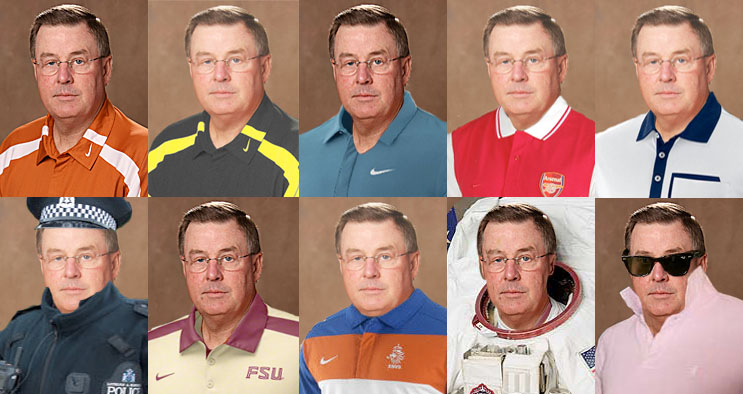
Greg Davis totally-not-a-photoshop via BHGP, obviously
Due to the nature of available video, the lack of teams that are remotely comparable to Michigan either in style or skill, and the strange ways of the universe, I once again am here to do an opponent breakdown using a game involving Northwestern. Yes, Northwestern lost. Yes, it happened in overtime. It's not your fault, Northwestern fans. It's not your fault.
Anyway, Iowa drove for a touchdown on their first drive, scored just three points in the rest of regulation, missed a potential game-winning field goal in the fourth quarter, threw an interception with a chance to get into field goal range at the very end of regulation, and then scored the eventual game-winning touchdown on their first possession of overtime. This is a team that leans on its stellar defense to carry most of the load while their offense attempts to bash its way downfield; that said, this isn't last year's Iowa offense, which is a good thing for Iowa.
Spread, Pro-Style, or Hybrid? Pro-style. Iowa utilizes a ton of two-TE sets, runs most of their offense from under center, and goes into the shotgun almost exclusively for obvious passing downs.
Basketball on Grass or MANBALL? Iowa ran almost entirely zone blocking concepts in this game, with the exception of a couple I-form power plays that weren't effective beyond getting two or three yards. Their linemen are very well suited to zone blocking, as you'll see below.
Hurry it up or grind it out? I don't mean to alarm you, but Iowa has gone to a no-huddle offense. I repeat: IOWA HAS GONE TO A NO-HUDDLE OFFENSE. THIS IS NOT A DRILL.
Yes, that is the Hawkeye offense full-blown tempo-ing Northwestern for a critical fourth-down conversion despite the umpire inexplicably standing on top of the ball and allowing the Wildcats to get set. This was the key sequence in a drive featuring Iowa playing at a pace resembling Penn State's up-tempo stuff until they hit the red zone, when they got more deliberate and scored a touchdown. They maintained the no-huddle throughout the game, though the pace slowed as the game wore on, in part because Iowa held a lead for much of the game.
Quarterback Dilithium Level (Scale: 1 [Navarre] to 10 [Denard]): Jake Rudock is by no means a burner; he's nimble enough to escape the pocket and do some damage with his legs (like in the video above), however, and Iowa even ran a couple zone reads with him. I'll give him a 6; he's rushed for 220 yards on 40 carries (5.6 ypc) with five touchdowns once sacks are removed.
[Hit THE JUMP for the rest of the breakdown.]
Dangerman: I'm pretty sure this is the first time I'm giving this to an offensive lineman, which means the guy really had to stand out because I'm still learning the finer points of watching/evaluating line play. Iowa based their gameplan around the zone stretch, made little effort to hide this fact, and ran it quite successfully for much of the game in large part because left tackle Brandon Scherff consistently mashed guys several yards downfield:
Iowa's top two backs, Mark Weisman and Damon Bullock, combined to rush for 108 yards on 30 carries (3.6 ypc), which isn't very impressive; looking deeper into the numbers, however, it's noteworthy that neither had a run longer than 11 yards (Bullock's long was just seven). Just about everything the Hawkeyes gained on the ground was due to their line, which is 12th in the country in tackles for loss allowed despite executing gameplans that are relatively predictable.
Zook Factor: The hurry-to-the-line fourth-down conversion nearly caused my head to explode; thankfully, it didn't, so I got to witness Ferentz call for a punt on 4th-and-3 from the NW 41 on the very next possession. In somewhat less egregious decisions, he also had them punt on 4th-and-6 from the NW 43. Naturally, the first punt was downed at the one while the second went for a touchback.
HenneChart: For some reason, whoever uploaded this game excised both of Iowa's fourth-quarter drives except for the interception, which is charted. That leaves seven attempts from Rudock uncharted; he was 6/7 for 53 yards on those throws, two of which netted negative yardage. Here's the chart of throws I could actually watch:
| Opponent | DO | CA | MA | IN | BR | TA | BA | PR | SCR | DSR |
|---|---|---|---|---|---|---|---|---|---|---|
| Northwestern | 2 | 9 (3) | -- | 1 | 2 | 3 | 1 | -- | 2 | 68% |
The interception is marked as a bad read, as Rudock tried to throw one through multiple defenders, though it wasn't too egregious considering the situation: 4th-and-11 at the Northwestern 35, apparently out of their kicker's range in this game, with under 15 seconds left in the game and the score tied. The pick functioned the same as an incompletion here and actually saved Iowa some field position in case of a hail mary attempt.
Overall, the success rate is quite solid, and I came away impressed with Rudock; while plenty of those throws were of the short-to-intermediate variety—remember, GERG Davis calling plays—he read Northwestern's zones well and fit some very nice throws into relatively small windows downfield. Then there was the overtime touchdown, which was downright spectacular:
That would've been a nice throw without the pressure; with two unblocked blitzers getting in his face immediately, it was a no-question DO.
OVERVIEW
Formation chart:
| Formations | Run | Pass | PA |
|---|---|---|---|
| Gun | 2 | 11 | 1 |
| I-Form | 10 | 3 | 1 |
| Ace | 18 | 2 | 5 |
| Pistol | -- | -- | -- |
Like I said, this offense isn't designed to fool you; under center usually means run, shotgun is almost always pass. Iowa's most frequently deployed formation was a two-TE Ace set that usually featured the H-back going in motion or at least bluffing motion to see if the defense was in man or zone. It looks like this:
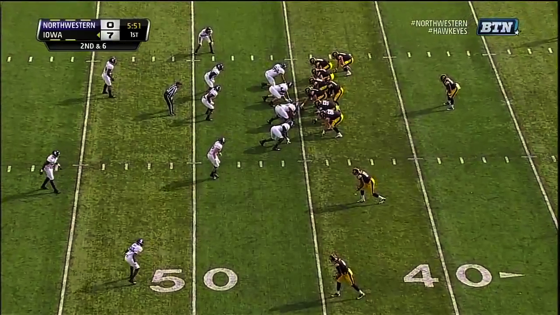
Really exciting stuff, I know. As for the distribution of plays by down:
| Down | Run | Pass | PA |
|---|---|---|---|
| 1st | 14 | 4 | 4 |
| 2nd | 11 | 4 | 3 |
| 3rd | 5 | 7 | -- |
If the running game is at all effective, Iowa is very content to go run-run-pass (or preferably run-run for a first down or run-run-run). First down play-action counted as trickery for these guys and resulted in some of their best passing plays of the day. While TE/H-back Jake Duzey dropped the ball on their one attempt to execute this particular play, they should've had a very nice gain by leaking him across the backside of the formation while faking the zone stretch to the strong side; expect to see this action at least once on Saturday.
I've already brought up the line play in the Dangerman section, but it's worth discussing further. Not only is the line very nimble and adept at zone blocking, they've done a fantastic job this year of keeping Rudock upright—just nine sacks allowed on 307 pass attempts this season, a rate just under 3%. Part of this is attributed to Rudock's ability to escape the pocket; he only had to do this a couple times, however, and the line usually gave him plenty of time and space to throw.
Weisman and Bullock are unspectacular backs who mostly get what they're given by the line. Weisman is a glorified fullback who knows how to find the hole and occasionaly crush through a tackle; he's also not going to make anybody miss. Bullock has more speed and displays a decent first cut; his vision isn't on par with Weisman's and he goes down rather easily upon contact.
Kevonte Martin-Manley is the go-to receiver in the offense, and his output in this game was pretty representative of how he's done this year: five catches, 45 yards, with a couple critical first down conversions. He's averaging under nine yards per catch this year and has 15 more receptions than the next-closest Hawkeye, tight end C.J. Fiedorowicz. Sophomore Tevaun Smith is the #2 option on the outside; at 6'2", 200 pounds, he provides a nice target for Rudock, but he wasn't great at getting separation in this one despite catching three passes for 41 yards; given his season stat-line of 19 catches for 213 yards, this seems to be par for the course.
Fiedorowicz and Duzey provide a solid one-two punch at TE/H-back and consistently threaten the flats and seams; both are also decent enough athletes to break some plays big—Duzey had an 85-yard touchdown grab against Ohio State in which he got over the top of Armani Reeves on a wheel route and outran the secondary to the end zone.
The key against this team is making sure they can't consistently grind out 4-5 yards on first and second down; they simply don't have many players who threaten downfield, and Rudock has thrown nine picks this season despite the plethora of screens and quick passes. In the play breakdown, we'll look at how Iowa was able to convert in a third-and-medium situation against Northwestern...
PLAY BREAKDOWN
Iowa faces a third-and-five here, and they'll run a triangle route concept out of a shotgun trips formation. I've even gone all fancy and diagrammed it out for you:
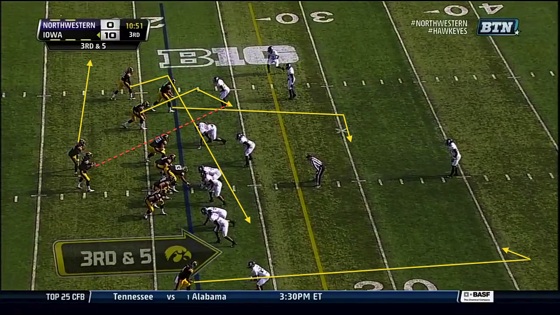
These route combinations are difficult to stop regardless of what coverage the defense is playing, and this one wreaked havoc on Northwestern's Cover 2 for an easy conversion. After the snap, you can see Iowa getting into their routes as the Wildcats sink into their zones—the running back's flare route ensures that the cornerback at the far hash can't help inside, while the deep in (Fiedorowicz, smack in the middle of the field at the first down line) is clearing things out underneath:
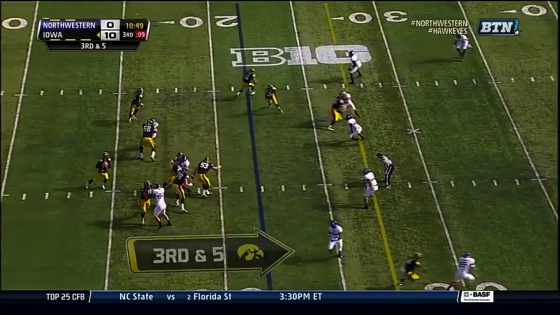
The middle linebacker has to stay at home against the shallow crossing route, which opens up tons of space for Martin-Manley, who's running a trail route behind it:
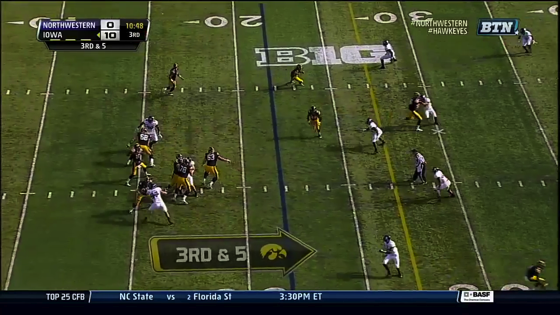
Easy catch in space allows KMM to pick up the first down yardage:

Video:
That's a very easy read/throw to make; this is an obvious point—it'd be nice to keep Iowa out of third-and-manageable situations and force Rudock to make more difficult downfield reads, and that all comes back to the run defense.